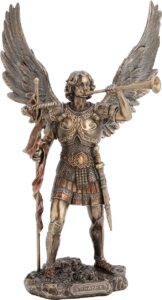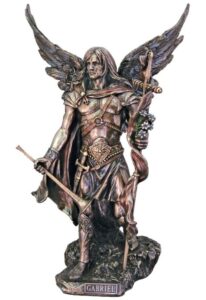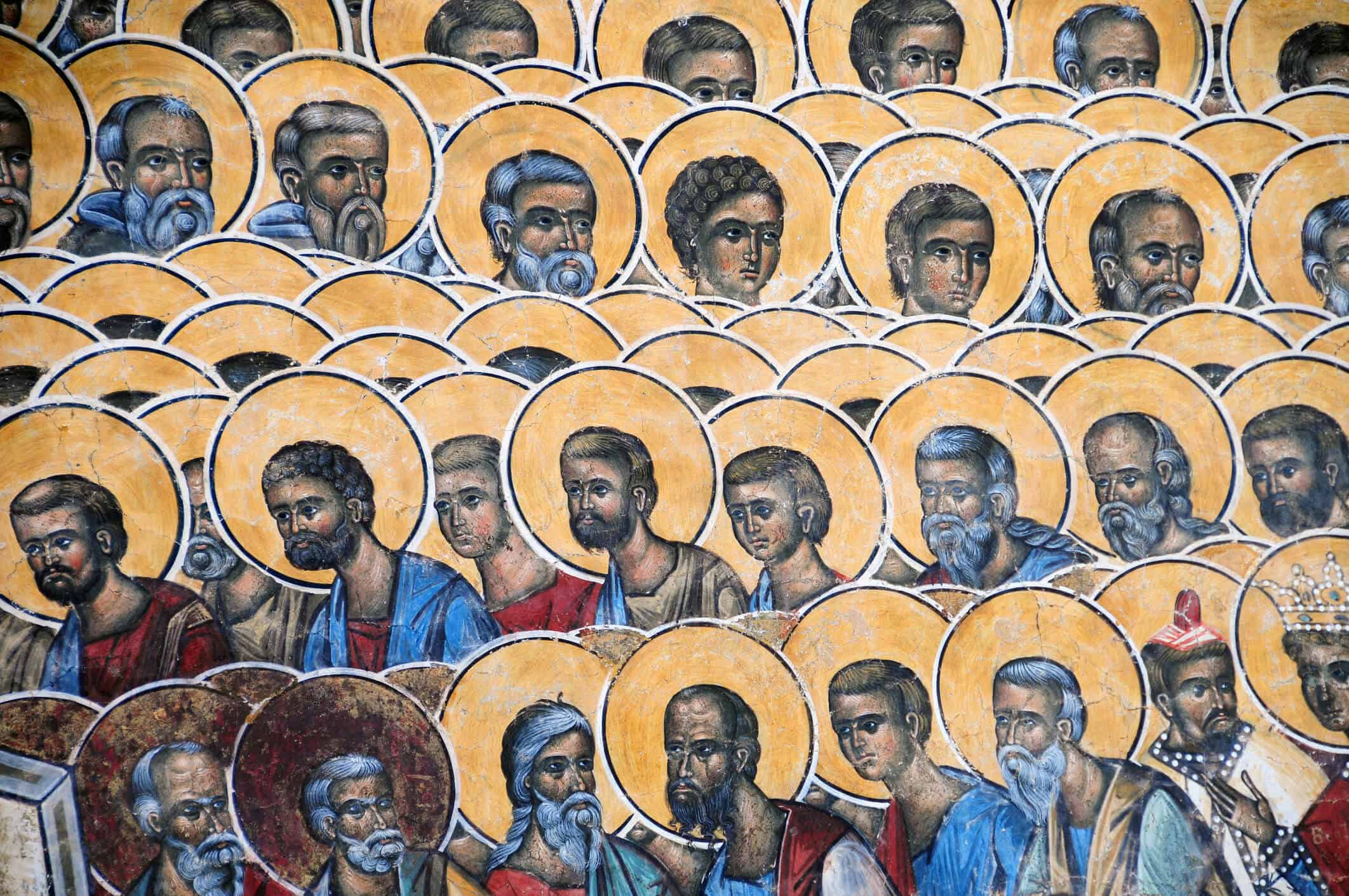September 4
Servant of God Fr. Vincent Capodanno
Vincent Robert Capodanno was born the tenth child of a large Italian family on Staten Island, NY on February 13, 1929. He took night classes at Fordham University while working as an insurance salesman. The service of three of his brothers in World War II fostered in him both an intense patriotism and willingness to profess his faith. In 1949 he entered the seminary in Ossining, NY and was ordained a Maryknoll priest in 1958. He served as a missionary in Taiwan for six years and was then assigned to a Maryknoll school in Hong Kong. He joined the Navy Chaplain Corps in 1965, serving the spiritual needs of the Marines in Vietnam. He lived, ate, and slept with those in his charge, in whatever circumstances they found themselves. So faithful was he in his service that the Marines nicknamed him the “Grunt Padre”.
Fr. Capodanno volunteered to travel with a Marine unit being sent to the dangerous Que Son Valley. On September 4, 1967 his unit of 500 soldiers arrived in the valley to support a small Marine detachment that was ambushed by a 2,500 member North Vietnamese unit. Unarmed, he was comforting the wounded and administering last rites to the dying when he was severely wounded by a mortar round that severed part of his right hand, as well as inflicting injuries to his face and legs. Despite his injuries, he attempted to help move a wounded Marine corpsman and two others out of the field of fire of a North Vietnamese machine gun, only 15 yards away from the wounded. He was struck and killed by over 20 bullets in a burst of machine gun fire.
Fr. Capodanno is one of 16 clergy on the Vietnam Memorial Wall in Washington, DC. He was the recipient of the Navy Bronze Star medal, the Vietnamese Cross of Gallantry with Silver Star, and the Purple Heart; he was posthumously awarded the Medal of Honor in 1969. His cause for canonization was been opened in 2002, and he was designated as a “Servant of God” on the weekend of Memorial Day in 2006.
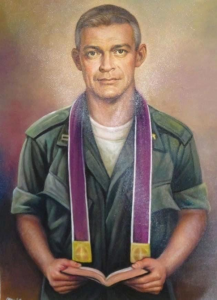
“We are drawn by a great priest who was faithful to his vocation. Remember that in the daily fulfillment of your duties, dear brother priests.”
Timothy Broglio
Archbishop for the Military Services
September 5
St. Teresa of Calcutta
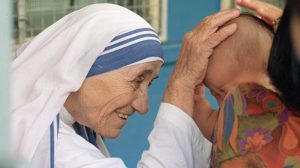
We think sometimes that poverty is only being hungry, naked and homeless. The poverty of being unwanted, unloved and uncared for is the greatest poverty. We must start in our own homes to remedy this kind of poverty.
Mother Teresa
Gonxha Agnes Bojaxhiu was born to Albanian parents, Nikola and Drane Bojaxhiu, in Skopje, Macedonia on August 26, 1910. She celebrated her First Communion at the age of 5 and was confirmed a year later; shortly after, her father died. She was very involved in the life of her parish, and in high school, she joined a Catholic sodality and showed a strong interest in foreign missions. At age 18, she left her home and joined the Institute of the Blessed Virgin Mary in Dublin, known as the Loreto Sisters of Dublin. She received the name Sister Mary Teresa after St. Therese of Lisieux.
In 1929, she left her home and traveled to the Loreto Entally community in Calcutta, and taught at St. Mary’s School for girls, where she taught for years, eventually becoming the school’s principal. On September 10, 1946 while traveling to her annual retreat in Darjeeling, she had a mystical experience in which she was called to “follow Christ into the slums to serve him among the poorest of the poor.” From that moment, service to the poor the became the driving force of her life.
After two years she received permission to leave her order. She took a nursing course and returned to Calcutta, India to begin her mission. On December 21, she went for the first time to the slums. She visited families, washed the sores of some children, cared for an old man lying sick on the road and nursed a woman dying of hunger and tuberculosis. She started each day with communion then went out, rosary in her hand, to find and serve Jesus in the poor of Calcutta. Gathering volunteers around her, she formed the Missionaries of Charity on October 7, 1950. For the next 40 years, until her death in 1997, she served the poorest of her neighbors through hostels for the dying, caring for lepers, and tending orphans, the abandoned, and the elderly poor; for the unwanted, the unloved, and the uncared for.
September 9
Bl. Frederic Ozanam
Frederic Ozanam was born in France in 1813 to Jean and Marie Ozanam, the fifth of 14 children. Only two of his siblings and he survived to adulthood. As a young man, he experienced grave doubts about his faith, but eventually over came them and became a journalist contributing to Catholic periodicals.
He studied law at the Sorbonne in Paris. There, he encountered a culture of materialism that held the Church in open contempt. Frederic gathered around him other students devoted to the Church and formed a discussion group cslled the “Conference of History,” which quickly became a cemter of lively discussions and debates.
During one of those sessions, a skeptical student asked him, “What is your church doing now? What is she doing for the poor of Paris? Show us your works and we will believe you!” Stung by the question, he realized he needed to ground his beliefs in action. The first thing he and his roommate did was to donate their winter’s supply of firewood to a widow whose husband had died of cholera. He founded a Council of Charity dedicated to reaching out to the poorest of the poor in Paris and aiding them.
In 1841, he married Amélie Soulacroix; they had a daughter, Marie. Onam became a full professor of foreign literature at the Sorbonne, He led an extremely active life as professor, academic writer, journalist, and as a member of the Council of Charity, now named the Society of St. Vincent de Paul. Having a weak constitution, he fell prey to consumption and died at the age of 40.
By the time of his death, the Society of St. Vincent de Paul consisted of 2,000 members. Today, the work continues in what evolved to be the Society of St. Vincent de Paul, with 800,000 members in some 140 countries worldwide, whose members operate through “conferences”. Each conference is composed of Catholic and non-Catholic volunteers who dedicate their time and resources to help those in need in their community.
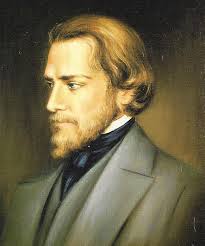
“The poor we see with the eyes of flesh; they are there and we can put finger and hand in their wounds and the scars of the crown of thorns are visible on their foreheads; and at this point incredulity no longer has place and we should fall at their feet and say with the Apostle, Tu est Dominus et Deus meus (You are my Lord and my God!). You are our masters, and we will be your servants. You are for us the sacred images of that God whom we do not see, and not knowing how to love Him otherwise shall we not love Him in your person.”
Bl. Frederic Ozanam
September 13
St. John Chrysostom
John was born about 344 of Christian parents in Antioch, Syria; where he spent most of his life. John’s father Secundus died when he was an infant, and he was raised by his very pious mother Anthusa, widowed at the age of twenty. He was well educated, and studied rhetoric under Libanius, one of the most famous orators of the age.
In 374 he withdrew to the mountains near Antioch to follow a life as an anchorite, a religious recluse. After twelve years he was forced to return to the city because of poor health, but during the last two years of his life as a hermit, he was able to memorize the entire New Testament. He wqas ordained a priest in 386. For a dozen years he preached in Antioch, where he gained the reputation as the best speaker in the Empire.
In 398 he was lured away from Antioch under false pretenses, and found himself removed to Constantinople, where he was elevated to the bishop of the capital of the Empire. Unlike his easy-going predecessor, John continued his ascetic life style and immediately began to seek to reform the See; including clergy, religious orders and the imperial court itself, making an enemy of the Empress Eudoxia. He was forced into a short exile due to political intrigue and outright slander.
His return to Constantinople was short lived. Opposition to him led to violence and bloodshed; two attempts were made to assassinate John, before he was framed for arson, for the burning of the cathedral. He was exiled to Cucusus in Armenia, which he called “the most desolate place in the whole world.” Fever, harsh treatment and severe cold led to his death on September 14, 407.
It was for his sermons that John earned the title Chrysostom, or “golden mouthed”. They were always on point, and they explained the Scriptures with clarity. He often espoused the duty of caring for the poor, and railed against the theaters of the time. He left more volumes of his writings than any other Father of the Church, and his explanations of the Mass and the priesthood gained him the title “Doctor of the Eucharist”. Along with St. Basil, St. Gregory Nazianzen and St. Athanasius, he is counted as one of the four great Eastern Doctors of the Church.
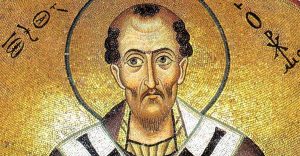
“Jesus Christ, the God-Man, was born in a manger and is spiritually reborn on the altar. He suffered on Calvary and continues to offer Himself on the altar. In His earthly life,
St. John Chrysostom
He spread His teaching and worked miracles among the crowds.
In the Eucharist, He spans the centuries and communicates Himself to all.”
September 15
Our Lady of Sorrows
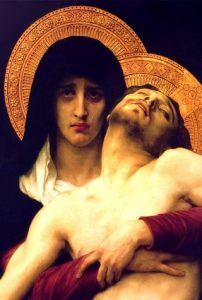
The Feast of Our Lady of Sorrows is one of several times during the year when Catholics pause to contemplate the role of the mother of Jesus in our faith history. Through her, our Salvation entered the world and was made flesh. This feast recalls especially the prophecy of Simeon’s in Luke’s Gospel, “This child [Jesus] is destined to be the downfall and the rise of many in Israel, a sign that will be opposed and you yourself shall be pierced with a sword so that the thoughts of many hearts may be laid bare (Luke 2:34-35). Many early Church writers interpreted the sword as Mary’s sorrows, especially as she saw Jesus die on the cross.
The Seven Sorrows of Mary are events in the life of the Blessed Virgin Mary that are a popular devotion They represent the participation of Mary in the life of her son, at those moments when she united herself, with a maternal heart, to His sacrifice. They are:
1. The Prophecy of Simeon. (Luke 2:34–35)
2. The escape and Flight into Egypt. (Matthew 2:13)
3. The Loss of the Child Jesus in the Temple of Jerusalem. (Luke 2:43–45)
4. The Meeting of Mary and Jesus on the Via Dolorosa.
5. The Crucifixion of Jesus on Mount Calvary. (John 19:25)
6. The Piercing of the Side of Jesus with a spear, and His Descent from the Cross. (Matthew 27:57–59)
7. The Burial of Jesus by Joseph of Arimathea. (John 19:40–42)
September 17
St. Hildegard of Bingen
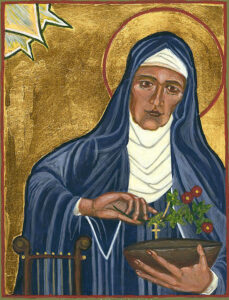
“I am the fiery life of the essence of God; I am the flame above the beauty in the fields; I shine in the waters; I burn in the sun, the moon, and the stars. And with the airy wind, I quicken all things vitally by an unseen, all-sustaining life.”
St. Hildegard of Bingen
Saint Hildegard of Bingen (1098-1179) is often viewed as a Renaissance woman, even though she lived before the time that is typically considered the Renaissance in Europe. A look at her life and her tremendous array of talents and achievements reveals why. At a time when few women wrote, Hildegard produced major works of theology and visionary writings. When few women were respected, she was consulted by and advised bishops, popes, and kings. She used the curative powers of natural objects for healing, and wrote treatises about natural history and the medicinal uses of plants, animals, trees and stones. She is the first musical composer whose biography is known. She founded a vibrant convent, where her musical plays were performed.
Hildegard was the tenth child born to a noble family. As was customary with the tenth child, which the family could not count on feeding, and who could be considered a tithe, she was dedicated at birth to the Church. The girl started to have visions of luminous objects at the age of three, but soon realized she was unique in this ability and hid this gift for many years. Raised in a Benedictine monastery, Saint Hildegard became the abbess at 38 and founded two additional monasteries for women. She was an author, philosopher, theologian, composer, artist, pharmacist and more. That repository of talent is unusual for any person in any time period, but is particularly rare for a woman of her time.
Saint Hildegard was a mystic. Her visions began very early in her life and inspired her teaching and writing. In 1141 a vision of God gave Hildegard instant understanding of the meaning of religious texts. He commanded her to write down everything she would observe in her visions. Though she never doubted the divine origin of her visions, Hildegard wanted them to be approved by the Church. She wrote to Saint Bernard who took the matter to Pope Eugenius who exhorted Hildegard to finish her writings.
In 2012, Pope Benedict XVI named Saint Hildegard a Doctor of the Church, making her the fourth woman of 35 saints to be given that title by the Roman Catholic Church. Pope Benedict XVI called Hildegard, “perennially relevant” and “an authentic teacher of theology and a profound scholar of natural science and music.”
September 23
St. Pio of Pietrelcina
Padre Pio (Francesco Forgione) was born to Giuseppa and Grazio Forgione, in the small farming town of Pietrelcina, Italy on May 25, 1887. At the age of five, he dedicated his life to God. When Francesco was fifteen years old, he was admitted to the novitiate of the Capuchin Order of the Friars Minor. On August 10, 1910, at the age of twenty-three, Padre Pio was ordained to the priesthood.
The celebration of the Holy Mass was for Padre Pio, the center of his spirituality. Due to the long pauses of contemplative silence into which he entered at various parts of the Holy Sacrifice, his Mass could sometimes last several hours. “God knows that I want to say Mass just like any other priest, but I cannot do it.”
His day began at 2:30 a.m. when he would rise to begin his prayers and to make his preparation for Mass. He was able to carry on a busy apostolate with only a few hours of sleep each night and an amount of food that was so small (300-400 calories a day) that his fellow priests stated that it was not enough food even to keep a small child alive. Between Mass and confessions, his workday lasted 19 hours. He never read a newspaper or listened to the radio or watched television. Pilgrims began to come to him by the thousands, from every corner of the world
The marks of the stigmata, the wounds of Christ, appeared on Padre Pio’s body, on Friday, September 20, 1918, while he was praying before a crucifix and making his thanksgiving after Mass. He was thirty-one years old and became the first stigmatized priest in the history of the Church. With resignation and serenity, he bore the painful wounds in his hands, feet, and side for fifty years.
Serene and well prepared, he surrendered to Sister Death on September 23, 1968, at the age of eighty-one. He died as he had lived, with his Rosary in his hands. His last words were Gesú, Maria – Jesus, Mary – which he repeated over and over until he breathed his last. He had often declared, “After my death, I will do more. My real mission will begin after my death.”
Drawing approximately eight million pilgrims each year, San Giovanni Rotondo, where St. Pio lived and is now buried, is second only to the shrine of Our Lady of Guadalupe in Mexico in its number of annual visitors.
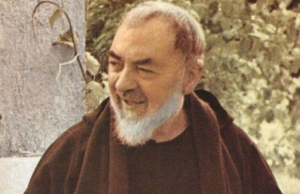
“Joy, with peace, is the sister of charity. Serve the Lord with laughter.“
St. Padre Pio
September 27
St. Vincent de Paul
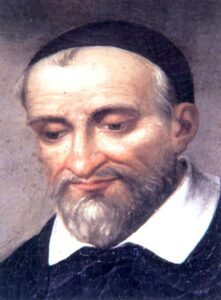
“Behold, now, how little is needed to become a Saint? Nothing more than to acquire the habit of willing, on every occasion, what God wills.”
St. Vincent de Paul
Vincent de Paul was born into a French peasant family in Pouy on April 24, 1581. He was an excellent student and was hired as a tutor to the children of a nearby wealthy family. He was ordained a priest at 19, and completed his theological studies 4 years later. In 1605, while on a ship traveling from Marseilles to Narbone, he was captured, brought to Tunis and sold as a slave. Two years later he and his master managed to escape and both returned to France.
After a brief stay in Rome, Vincent became chaplain to the Count of Goigny and was placed in charge of distributing money to the deserving poor. The deathbed confession of a dying servant opened Vincent de Paul’s eyes to the crying spiritual needs of the peasantry of France. This seems to have been a crucial moment in the life of the man from a small farm in Gascony, France, who had become a priest with little more ambition than to have a comfortable life.
After working for some time in Paris among imprisoned galley-slaves, he influenced a number of young men, some of them priests, to join him in forming a religious group to be called the Congregation of the Mission, sponsored by the Countess of Goigny. Vincent and his friends worked with the poor people of the countryside near Paris, helping them obtain food and clothing and teaching them about Christ. The Congregation evolved into the Vincentian order.
The Vincentians remain with us today with nearly 4,000 members in 86 countries. In addition to his order of Vincentian priests, St. Vincent cofounded the Daughters of Charity along with St. Louise de Marillac. There are more than 18,000 Daughters today serving the needs of the poor in 94 countries. Pope Leo XIII made him the patron of all charitable societies. Outstanding among these, of course, is the Society of St. Vincent de Paul, founded in 1833 by his admirer Blessed Frédéric Ozanam.
He was eighty years old when he died in Paris on September 27, 1660. His incorrupt heart can be found in the Convent of the Sisters of Charity and his bones have been embedded in a wax effigy of the Saint located at the Church of the Lazarist Mission. Both sites are located in Paris, France.
September 29
Feast of the Archangels
The Archangels St. Gabriel, St. Michael, and St. Raphael share a feast day on September 29th. These are the only three angels mentioned by name in Sacred Scripture.
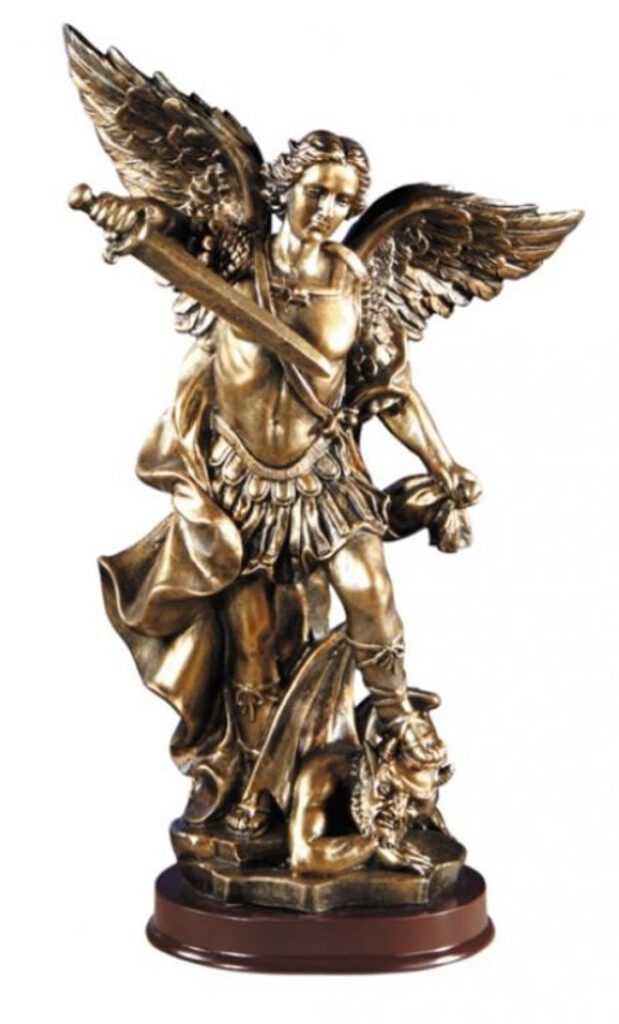
Angels are pure, created spirits. The name “angel” means servant or messenger of God. Angels are celestial or heavenly beings, on a higher order than human beings. Angels have no bodies and do not depend on matter for their existence or activity. They stand before the throne of God, but are distinct from saints, which men aspire to become. Angels have intellect and will and are immortal. They are a vast multitude but each is an individual.
St. Gabriel means “Power of God.” Biblically he appears three times as a messenger. He was sent to Daniel to explain a vision concerning the Messiah. He appeared to Zachary when he was offering incense in the Temple, to foretell the birth of his son, St John the Baptist. And he is the messenger or herald angel most famous for appearing to the Blessed Virgin Mary at the Annunciation (Luke 1:11-38).
St. Michael means “Who is like God?” He is the warrior angel, the famous “prince of the heavenly hosts” and foe of Satan. He appears four times in Scripture, twice in the Book of Daniel and once each in the Epistle of St Jude and the Book of Revelation. In the book of Revelation, he is spoken of when he and his hostthrow down Satan and the other fallen angels in a great battle. He is the champion of God’s people and guardian and protector of the Church (Rev. 12:7-9).
St. Raphael means “God has healed.” He is a companion and healing angel, most famous for curing Tobit’s blindness and for traveling with Tobiah in the book of Tobit (Tob. 12). His mission as wonderful healer and fellow traveler with the youthful Tobias has caused him to be invoked for journeys and at critical moments in life. Tradition also holds that Raphael is the angel that stirred the waters at the healing sheep pool in Bethesda.
